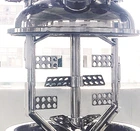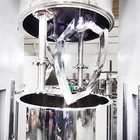Best Mixing Equipment for High-Viscosity Products: Silicone, Glue, Solder Paste
Many companies underestimate how much the nature of their product can influence the choice of mixing equipment. Choosing the wrong machine can result in wasted time, money, and raw materials. That’s why identifying the key characteristics of your product—such as viscosity—is essential. Viscosity refers to how thick or thin a material is, and it plays a critical role in determining the right mixing solution.
In our previous article, “Top 5 Mistakes to Avoid When Buying a Filling Machine: Technical Mistakes,” we explored how viscosity affects filling processes. In this article, we’ll focus on the best mixing machines for high-viscosity products.
Understanding the Challenge of High-Viscosity Materials
- High viscosity means the material is thick and resists flow—think honey, peanut butter, or cold syrup.
- These materials require strong shear forces for proper mixing.
- Mixing must be thorough to avoid air bubbles, unmixed clumps, or inconsistent texture.
- It’s also essential to avoid overheating or degrading the product during mixing.
What Can Go Wrong with the Wrong Mixing Equipment
Using a mixer that isn't designed for high-viscosity materials doesn't just reduce efficiency—it can lead to serious operational and product issues:
- Incomplete Mixing: Ingredients may not blend uniformly, leading to poor product quality or separation over time.
- Air Entrapment: Air bubbles can form and remain trapped, affecting performance in applications like sealing or electrical conductivity.
- Product Waste: Viscous materials often stick to poorly designed equipment, causing loss of expensive product.
- Overheating or Premature Curing: Excess friction from unsuitable mixers can damage heat-sensitive components.
- Excessive Machine Wear: Light-duty mixers can overheat or break when forced to process thick materials.
- Inconsistent Batches: Lack of uniformity from batch to batch can result in product failure or customer complaints.
- Longer Production Times: Underpowered machines often require more time to achieve an acceptable mix.
- Cross-Contamination: Inadequate cleaning due to sticky residue can impact the next batch.
- Safety Risks: Overloaded or mismatched machines can pose hazards to operators through overheating, spills, or pressure failures.
These risks highlight why the right equipment is more than just a convenience—it's critical for process efficiency, product quality, and long-term profitability.
Types of Mixing Equipment for High-Viscosity Products
a) Planetary Mixers (Dual or Triple Shaft)
- How it works: The blades rotate on their own axis while orbiting the mixing bowl—like planets around the sun.
- Why it’s ideal: Excellent for thick materials, as it scrapes the bowl walls and mixes thoroughly.
- Features: Strong motor, multiple mixing tools like scrapers and kneaders.
- Common uses: Silicone, epoxy resins, heavy adhesives.
- Example: Double planetary mixers are often customizable based on batch size, motor power, and tooling. Pricing varies depending on these specifications.
b) High Shear Mixers
- How it works: A fast-spinning rotor shears material against a stationary stator.
- Why it’s ideal: Delivers intense shear forces to break up lumps and ensure a uniform mix.
- Limitations: Can generate heat, which may affect heat-sensitive materials.
- Common uses: Glue, thick pastes.
- Example: High shear mixers can be tailored to viscosity levels and production volume requirements. They may carry a higher cost but improve product homogeneity and reduce mixing time.
c) Static Mixers (for Continuous Mixing)
- How it works: The material flows through a tube with fixed internal elements that split and recombine the flow.
- Why it’s ideal: Simple and effective for continuous production; no moving parts mean low maintenance.
- Limitations: Requires good initial flow—less effective with extremely thick materials.
- Common uses: Two-component silicone, continuous adhesive mixing.
d) Kneader Mixers (Double Arm or Sigma Blade)
- How it works: Two arms knead and fold the material, similar to dough mixing.
- Why it’s ideal: Perfect for extremely viscous, sticky substances. Excellent for incorporating powders.
- Common uses: Silicone rubber, dense pastes, glue formulations.
- Example: Sigma blade mixers are often customized with different motor sizes and chamber volumes. These options influence pricing based on production needs.
e) Heavy-Duty Propeller Mixers
- How it works: A rotating shaft with a propeller blade mixes the product.
- Why it’s ideal: Effective for medium-viscosity materials when properly powered and equipped.
- Limitations: Less efficient than planetary or sigma mixers for very thick products.
- Common uses: Medium-viscosity adhesives.
Mixing equipment prices vary widely depending on customization factors such as batch size, motor power, tooling, and control features. While higher initial investments may be necessary for tailored solutions, the improved efficiency and product quality often justify the cost. Engaging with knowledgeable suppliers early in the process ensures the best balance between budget and performance.
|
Equipment Type |
Best For |
Pros |
Cons |
Other Uses (Low/Medium Viscosity) |
|
Planetary Mixer |
Silicone, epoxy, heavy glue |
Thorough mixing, scrapes bowl, versatile |
Expensive, large footprint |
Creams, lotions, mayonnaise, soft pastes |
|
High Shear Mixer |
Glue, solder paste |
Intense shear, breaks lumps |
Can heat product, expensive |
Emulsions, sauces, cosmetic gels |
|
Static Mixer |
Continuous adhesive mixing |
No moving parts, low maintenance |
Not for very thick paste alone |
Two-component low-viscosity sealants, light resins |
|
Kneader Mixer (Sigma) |
Silicone, heavy pastes |
Great for very thick, sticky materials |
Slower mixing speed |
Chocolate, cosmetic clays, thick creams |
|
Heavy Duty Propeller Mixer |
Medium-viscosity adhesives |
Simpler, lower cost |
Less effective for thick pastes |
Liquid soaps, body creams, sauces |
Key Features to Look for in Mixers for High-Viscosity Materials
No matter which type of mixer you choose, it should include key features to protect your product and ensure optimal performance:
- Powerful motor: Delivers high torque for thick materials
- Scrapers: Prevent buildup on mixing vessel walls
- Variable speed control: Tailors shear force and speed to your product
- Heating/cooling jacket: Maintains product temperature to prevent curing or degradation
- Vacuum capability: Removes air bubbles—especially important for silicone and solder paste
- Easy cleaning design: High-viscosity materials are sticky and hard to remove
- Material compatibility: Stainless steel or coated surfaces to prevent contamination
Your Turn to Choose
As you've seen, some machines are more expensive but offer better performance depending on what you're mixing. Be mindful: more options can lead to more mistakes. Don’t prioritize cost over efficiency. Instead:
- Discuss your needs with all stakeholders
- Choose a trusted supplier who can guide you
- Match the machine to the specific properties of your product
Choosing the right mixer isn't just about budget—it's about getting the best results and protecting your long-term investment.
If you're looking for additional guidance, the article [“Top 5 Mistakes to Avoid When Buying a Filling Machine: Technical Mistakes”] is a valuable resource. While it focuses on filling machines, many of its insights—such as evaluating suppliers, budgeting strategies, and matching technical specifications—are just as relevant when choosing mixing equipment. Think of it as a practical guide to help you avoid costly errors across your production line.














































































































